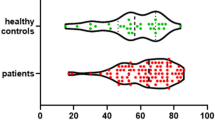Abstract
Background
Assessment of the default mode network (DMN) using resting-state functional magnetic resonance imaging (fMRI) may improve assessment of the level of consciousness in chronic brain injury, and therefore, fMRI may also have prognostic value in acute brain injury. However, fMRI is much more challenging in critically ill patients because of cardiovascular vulnerability, intravenous sedation, and artificial ventilation.
Methods
Using resting-state fMRI, we investigated the DMN in a convenience sample of patients with acute brain injury admitted to the intensive care unit. The DMN was classified dichotomously into “normal” and “grossly abnormal.” Clinical outcome was assessed at 3 months.
Results
Seven patients with acute brain injury (4 females; median age 37 years [range 14–71 years]; 1 traumatic brain injury [TBI]; 6 non-TBI) were investigated by fMRI a median of 15 days after injury (range 5–25 days). Neurological presentation included 2 coma, 1 vegetative state/unresponsive wakefulness syndrome (VS/UWS), 3 minimal conscious state (MCS) minus, and 1 MCS plus. Clinical outcomes at 3 months included 1 death, 1 VS/UWS, 1 MCS plus, and 4 conscious states (CS; 1 modified Rankin Scale 0; 2 mRS 4; 1 mRS 5). Normal DMNs were seen in 4 out of 7 patients (1 MCS plus, 3 CS at follow-up).
Conclusions
It is feasible to assess the DMN by resting-state fMRI in patients with acute brain injury already in the very early period of intensive care unit admission. Although preliminary data, all patients with a preserved DMN regained consciousness levels at follow-up compatible with MCS+ or better.



Similar content being viewed by others
References
Buckner RL, Andrews-Hanna JR, Schacter DL. The brain’s default network: anatomy, function, and relevance to disease. Ann N Y Acad Sci. 2008;1124:1–38.
Vanhaudenhuyse A, Noirhomme Q, Tshibanda LJ, et al. Default network connectivity reflects the level of consciousness in non-communicative brain-damaged patients. Brain. 2010;133:161–71.
Demertzi A, Antonopoulus G, Heine L, et al. Intrinsic functional connectivity differentiates minimally conscious from unresponsive patients. Brain. 2015;138:2619–31.
Fernández-Espejo D, Soddu A, Cruse D, et al. A role for the default mode network in the bases of disorders of consciousness. Ann Neurol. 2012;72:335–43.
Kondziella D, Friberg CK, Frokjaer VG, Fabricius M, Møller K. Preserved consciousness in vegetative and minimal conscious states: systematic review and meta-analysis. J Neurol Neurosurg Psychiatry. 2016;87:485–92.
Guldenmund P, Demertzi A, Boveroux P, et al. Thalamus, brainstem and salience network connectivity changes during propofol-induced sedation and unconsciousness. Brain Connect. 2013;3:273–85.
Song XX, Ju BW. Anesthetic effects of propofol in the healthy human brain: functional imaging evidence. J Anesth. 2015;29:279–88.
Kirsch M, Guldenmund P, Ali Bahri M, et al. Sedation of patients with disorders of consciousness during neuroimaging: effects on resting state functional brain connectivity. Anesth Analg. 2017;124:588–98.
The Multi-Society Task Force on PVS. Medical aspects of the persistent vegetative state (1). N Engl J Med. 1994;330:1499–508.
Laureys S, Celesia GG, Cohadon F, et al. Unresponsive wakefulness syndrome: a new name for the vegetative state or apallic syndrome. BMC Med. 2010;8:68.
Bruno MA, Majerus S, Boly M, et al. Functional neuroanatomy underlying the clinical subcategorization of minimal conscious state patients. J Neurol. 2012;259:1087–98.
Whitfield-Gabrieli S, Nieto-Castanon A. Conn: a functional connectivity toolbox for correlated and anticorrelated brain networks. Brain Connect. 2012;2:125–41.
Fox MD, Snyder AZ, Vincent JL, et al. The human brain is intrinsically organized into dynamic, anticorrelated functional networks. PNAS. 2005;102:9673–8.
Behzadi Y, Restom K, Liau J, Liu TT. A component based noise correction method (CompCor) for BOLD and perfusion based fMRI. Neuroimage. 2007;37:90–101.
Fisher PM, Larsen CB, Beliveau V, et al. Pharmacologically induced sex hormone fluctuation effects on resting-state functional connectivity in a risk model for depression: a randomized trial. Neuropsychopharmacology. 2017;42:446–53.
Naci L, Owen AM. Making every word count for nonresponsive patients. JAMA Neurol. 2013;70:1235–41.
Palanca BJ, Mitra A, Larson-Prior L, et al. Resting-state functional magnetic resonance imaging correlates of sevoflurane-induced unconsciousness. Anesthesiology. 2015;123:346–56.
Koenig MA, Holt JL, Ernst T, et al. MRI default mode network connectivity is associated with functional outcome after cardiopulmonary arrest. Neurocrit Care. 2014;20:348–57.
Norten L, Hutchinson RM, Young GB, et al. Disruptions of functional connectivity in the default mode network of comatose patients. Neurology. 2012;78:175–81.
Author information
Authors and Affiliations
Corresponding author
Ethics declarations
Conflict of interest
All authors declare that they have no conflict of interest.
Ethical Standard
All procedures performed were in accordance with the ethical standards of the institutional committee and with the 1964 Helsinki declaration and its later amendments.
Rights and permissions
About this article
Cite this article
Kondziella, D., Fisher, P.M., Larsen, V.A. et al. Functional MRI for Assessment of the Default Mode Network in Acute Brain Injury. Neurocrit Care 27, 401–406 (2017). https://doi.org/10.1007/s12028-017-0407-6
Published:
Issue Date:
DOI: https://doi.org/10.1007/s12028-017-0407-6




